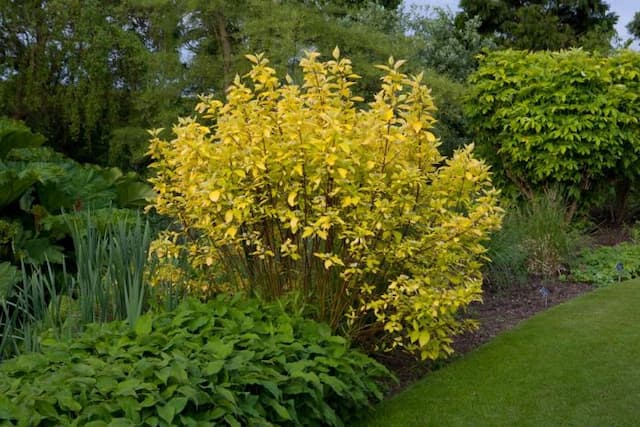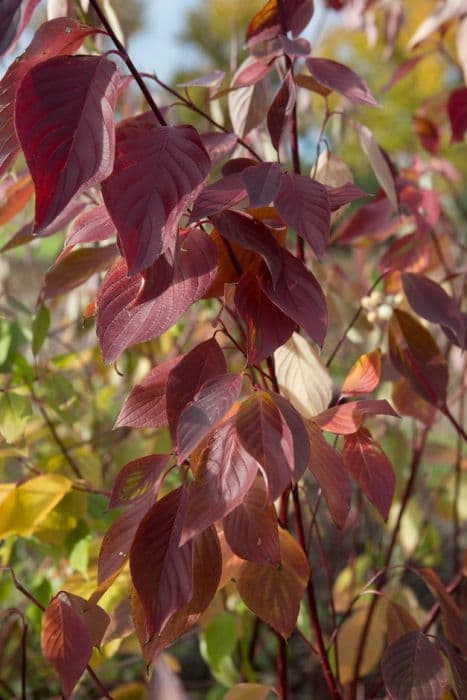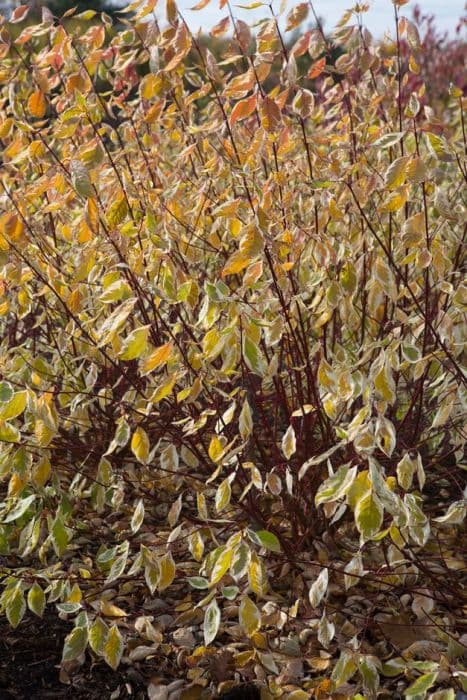Red Twig Dogwood Cornus alba Baton Rouge = 'Minbat' (PBR)
![dogwood [Baton Rouge]](/_next/image?url=https%3A%2F%2Fplants-admin.emdemapps.com%2Fimages%2Fplants%2F%2Fimages%2F604b59cf0fefd.png&w=3840&q=75)
ABOUT
The Cornus alba Baton Rouge, also known as 'Minbat' and commonly referred to as the red-twig dogwood, is a multi-season plant renowned for its vibrant and colorful appearance. During the spring and summer months, the foliage presents a rich green color providing a lush and dense canopy of leaves. The bright green leaves often showcase a striking contrast with white and creamy floral clusters, adding an ornamental touch to the rather verdant display. As autumn approaches, the foliage undergoes a dramatic transformation, turning into captivating shades of reddish-purple which contribute to an enchanting fall display. The true spectacle begins in winter when the leaves have fallen, revealing the bold, red stems that the red-twig dogwood is celebrated for. These fiery-hued branches stand out against the often-drab winter landscape, providing much-needed visual warmth and interest during the colder months. Not limited to foliage and stems, the plant may also bear fruit that can range in color from bluish-white to white, providing an additional ornamental feature as well as food for wildlife. The overall visual impact of the red-twig dogwood is one of striking color contrasts and seasonal change, making it a standout in any garden setting.
About this plant
 Names
NamesFamily
Cornaceae
Synonyms
Tatarian Dogwood, Siberian Dogwood, Red-barked Dogwood, Baton Rouge Dogwood
Common names
Cornus alba 'Minbat'.
 Toxicity
ToxicityTo humans
The Red Twig Dogwood is generally not considered poisonous to humans. However, consuming parts of the plant, particularly the berries, may cause mild stomach upset in some individuals. Symptoms can include nausea, vomiting, and diarrhea.
To pets
The Red Twig Dogwood is also not typically considered toxic to pets. It is relatively safe when pets are exposed to it in the landscape. However, as with humans, the consumption of large amounts of the plant might lead to gastrointestinal upset in some animals, with potential symptoms being vomiting and diarrhea.
 Characteristics
CharacteristicsLife cycle
Perennials
Foliage type
Deciduous
Color of leaves
Green
Flower color
White
Height
5 feet (1.52 meters)
Spread
6 feet (1.83 meters)
Plant type
Shrub
Hardiness zones
2
Native area
Asia
Benefits
 General Benefits
General Benefits- Year-round interest - Cornus alba 'Minbat' offers visual interest through all seasons with its colorful stems, foliage, and berries.
- Attractive stems - The bright red stems provide a striking contrast against winter landscapes when the plant is leafless.
- Easy to grow - This plant is hardy and adaptable, making it suitable for a variety of garden conditions and easy for gardeners to maintain.
- Wildlife-friendly - Produces berries that are a food source for birds and provides shelter for various species of wildlife.
- Tolerant of pruning - Can be easily pruned to shape, encouraging brighter stem color the following season.
- Low maintenance - Requires minimal care once established, making it a great option for both novice and experienced gardeners.
- Soil adaptability - Grows well in a range of soil types, although it prefers moist, well-drained soil.
- Pest resilience - Generally resistant to a variety of pests, reducing the need for chemical treatments.
 Medical Properties
Medical PropertiesThis plant is not used for medical purposes.
 Air-purifying Qualities
Air-purifying QualitiesThis plant is not specifically known for air purifying qualities.
 Other Uses
Other Uses- Cornus alba 'Baton Rouge' can act as a natural backdrop for photographic or artistic projects, providing a vibrant red color during winter that can enhance visual appeal.
- The branches of the Red Twig Dogwood can be used in basketry or as weaving materials for creating natural art and crafts.
- The colored twigs of the Red Twig Dogwood are popular in cut flower arrangements, especially during the winter, for both their structural form and color contrast.
- Red Twig Dogwood can be planted in outdoor play areas to create visually stimulating natural play structures for children.
- The plant can provide habitat and nesting materials for birds, as they may use the twigs to build nests in the spring.
- In landscape design, the 'Baton Rouge' variety is used to create contrasting patterns and color palettes with other plants in garden mosaics.
- During the holiday season, the bright red stems can be harvested and used as a natural decorative element in wreaths and festive arrangements.
- Being a fast-growing shrub, it can be used in erosion control on steep banks or areas prone to soil degradation.
- This variety can serve as a training plant for horticulture students, teaching them about pruning techniques to maintain vibrant stem color.
- The Red Twig Dogwood can be used in large public spaces or parks for creating thematic gardens, such as a 'Winter Interest Garden' focusing on plants with attributes that stand out in colder months.
Interesting Facts
 Feng Shui
Feng ShuiThe Tatarian Dogwood is not used in Feng Shui practice.
 Zodiac Sign Compitability
Zodiac Sign CompitabilityThe Tatarian Dogwood is not used in astrology practice.
 Plant Symbolism
Plant Symbolism- Hope: Cornus alba, commonly known as Tatarian Dogwood, is often associated with hope as its bright stems offer color to the winter landscape.
- Resilience: The plant’s ability to withstand harsh winter conditions symbolizes endurance through difficult times.
- Renewal: With its vibrant red stems that stand out in winter, it represents the promise of renewal and rebirth that comes with the changing seasons.
- Protection: Dogwood trees have been thought to offer protection due to their hard wood, which was believed to keep away evil.
 Water
WaterThe Tatarian Dogwood, commonly referred to as Red Twig Dogwood, should be watered deeply and thoroughly to ensure that the soil is moist but not waterlogged. During the first growing season, it's important to maintain consistent moisture, so watering once a week with approximately 1 to 1.5 gallons per plant is advisable, depending on the weather conditions. Once established, Red Twig Dogwood is quite drought-tolerant and may require less frequent watering, perhaps every two to three weeks if there is no significant rainfall. During hot summer months or dry spells, increase the frequency, ensuring the top few inches of soil don't dry out completely.
 Light
LightRed Twig Dogwood thrives in conditions ranging from full sun to partial shade. It performs best when it receives at least four hours of direct sunlight daily, making a spot that gets morning sun and afternoon shade ideal. This plant tolerates a wide range of light conditions, but for optimal foliage and stem color, full sun is preferred.
 Temperature
TemperatureRed Twig Dogwood is a hardy plant that can withstand a wide range of temperatures. It can survive minimum winter temperatures down to around -30°F and is comfortable in the heat of summer as long as it is well-watered. Ideal growing conditions would maintain temperatures between 50°F and 75°F for optimal growth and health.
 Pruning
PruningPrune Red Twig Dogwood in late winter or very early spring before new growth starts to encourage vibrant stem color and maintain plant shape. Remove about one-third of the oldest stems each year, cutting them back to the ground to stimulate the growth of new stems, which display the best color. Thinning out some of the center branches can improve air circulation, which is essential for the overall health of the plant.
 Cleaning
CleaningAs needed
 Soil
SoilThe Red Twig Dogwood (Cornus alba 'Baton Rouge') thrives best in well-drained, fertile soil with a pH of 5.5 to 7.5. A soil mix with loam, organic matter or compost, and a component to improve drainage, such as perlite or coarse sand, is ideal for ensuring healthy growth.
 Repotting
RepottingRed Twig Dogwood should be repotted every 2-3 years to prevent it from becoming root-bound and to replenish soil nutrients. Always ensure that the new pot is slightly larger than the old one.
 Humidity & Misting
Humidity & MistingRed Twig Dogwood prefers moderate humidity levels but is adaptable to a range of conditions. Aim for humidity levels consistent with its natural outdoor environment.
 Suitable locations
Suitable locationsIndoor
Use bright indirect light, moist soil.
Outdoor
Plant in sun to part-shade, moist soil.
Hardiness zone
2-7 USDA
 Life cycle
Life cycleCornus alba 'Baton Rouge', commonly known as Red Twig Dogwood, begins its life cycle from seed or vegetative propagation. After germination, the plant enters a juvenile vegetative stage, during which roots, stems, and leaves develop rapidly. As it matures, it progresses to the flowering stage, producing small white blossoms that are often followed by clusters of white to blueish fruits. Post-flowering, the plant focuses energy on fruit and seed development for reproduction, while the distinctive red stems that give 'Baton Rouge' its name become prominent in fall and winter. The plant then goes into dormancy during winter, conserving resources. With the return of spring, the cycle restarts with new vegetative growth, completing its annual cycle.
 Propogation
PropogationPropogation time
Spring-summer
The Cornus alba 'Baton Rouge' is commonly known as the Red Twig Dogwood, and its popular method of propagation is through hardwood cuttings. This process typically occurs in late fall or early winter when the plant is dormant. You would take a cutting of about 6 to 9 inches (15 to 23 centimeters) from a healthy, mature stem, ensuring that several buds are present. The lower leaves are removed, and the cut end can be dipped in rooting hormone powder to encourage root growth. The prepared cutting is then inserted into a well-draining potting mix, with about two-thirds of its length buried in the soil. The cutting should be kept in a cool but frost-free location with high humidity and indirect light until roots have developed, which usually takes several months. Once rooted, it can be transplanted to a more permanent location in the garden.



![Dogwood [Ivory Halo]](/_next/image?url=https%3A%2F%2Fplants-admin.emdemapps.com%2Fimages%2Fplants%2F%2Fimages%2F604b535cbcb9a.png&w=640&q=75)





![Dogwood [Venus]](/_next/image?url=https%3A%2F%2Fplants-admin.emdemapps.com%2Fimages%2Fplants%2F%2Fimages%2F604b58a531da1.png&w=640&q=75)